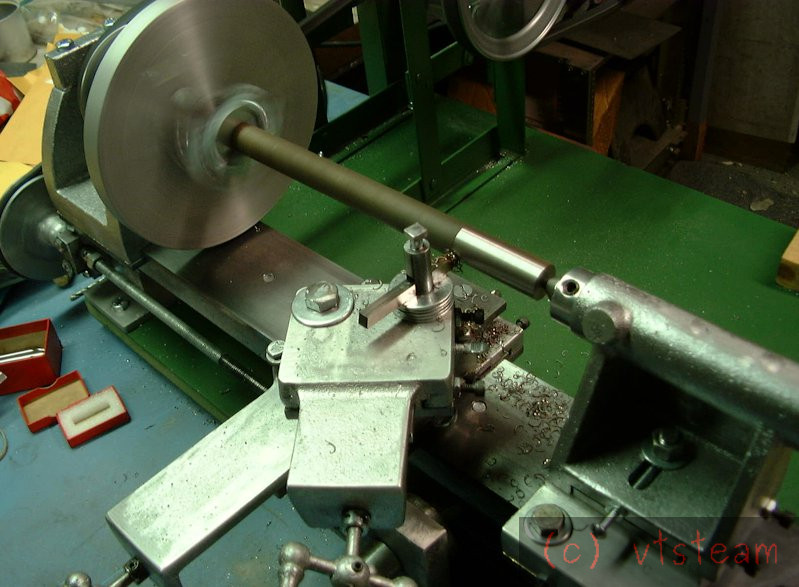The moment of truth.

This was a test bar I was turning just after I had made and mounted the tailstock and its slide. The idea was to see how far off the tailstock (and lathe in general) was, and set the tailstock over to compensate for the error.
Errors would be a result of headstock bearing bore, headstock bearings, headstock base attachment position, tail stock bore and attachment position, accuracy of bed ways and accuracy of scraping.
When I was finished turning the full length of the bar, I measured the ends and middle with my dial caliper. The total taper was less than 1/2 a thou over the full 12" length of the bar. I couldn't actually read it, since it was just over the line on the dial by a hair. I was amazed that I didn't have to adjust the tail stock set over at all.
How was this accuracy achieved with primitive tools and practically no measurement of position or angular orientation when building the lathe? The answer actually lies in the clever way that the headstock and tailstock are bored, and this is one of the more fascinating things about building this lathe.
To bore the headstock on a Gingery lathe, you complete the headstock base slides. Even though it will later be fixed in place, the headstock still has hand scraped slides, gibs and gib screws initially. You then mount the headstock and adjust the gibs for a close sliding fit. You fasten the headstock to the apron, so that it can be driven -- as if it were the cross slide. The cross slide is not yet mounted on the lathe.
Next you assemble a second temporary headstock, made out of angle plates and pillow bearings -- basically a bolt together structure that will support a driven boring bar. The boring bar is made up out of rod and a piece of lathe tool and placed in the temporary headstock. drive pulleys are added to the boring bar, and it is spun by the lathe motor.
You will start the boring bar rotating, then engage the leadscrew, which drives the apron and attached headstock onto the boring bar.
Now te question comes up, how do you get the boring bar exactly straight, at the proper height and perfectly parallel with the bed ways, because this will have a critical effect on the accuracy of the lathe.
Well the answer is, you don't. You just do the best you can by making a little gage out of sheet metal that the bar rests on while you tighten up the temp headstock bolts, and that's it for measurements.
Yet the bore comes out absolutely parallel (within less than a half thou over 12")
because of the way you are boring it! By sliding the headstock over the ways, the bore MUST be parallel with those ways. Even if your boring bar is slightly angled (and it won't be angled much) the bore will be parallel. The hole it bores may be very slightly elliptical, if the bar is angled but nevertheless parallel to the ways.
Not only that but the height is also not overly important either. Because after you bore the headstock, you are going to remove the temporary headstock, and replace it with the freshly bored casting and fasten it down permanently. Then fit it with bearings in the bore hole, ad the boring bar and pulley and get it ready to bore the tailstock. You will do this in exactly the same fashion you bored the headstock -- driving the tailstock with the apron onto the boring bar as the casting slides along the ways.
This means that not only will the tailstock be bored exactly parallel with the ways, but also that its center height will exactly match the center height of the headstock, and their bores will be exactly concentric!
This is a wonderful thing. At least it was to me, at the time. Precision without measurement, simply by the nature of a procedure. Pure elegance. There are several of these moments in the building of a Gingery lathe -- the making of square angle plates in a rotational machine, the boring of headstock and tailstock concentric and parallel, and the making of accurate surface plates by the method of threes, and hand scraping to high precision by simply looking at the pattern of oil paint on a surface.
These are amazing things that we can do.
